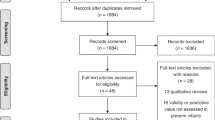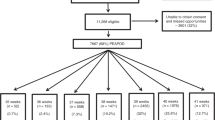Abstract
Detailed knowledge of body composition in preterm neonates during their later postnatal period may be important for the treatment process. However, little consideration has been given to test whether bioelectrical impedance analysis (BIA) is a useful bedside method to predict fat-free mass (FFM). The aim of the study is to assess whether BIA is a bedside method to measure FFM in preterm neonates. FFM of 118 white subjects (51 males, 67 females), mean gestational age of 30.1±3.1 weeks and birth weight of 1.26±0.47 kg, was measured at a gestational age of 38.6±3.8 weeks and actual body weight of 2.6±0.54 kg using dual energy X-ray absorptiometry (FFMDXA). Weight (W), height (Ht), and bioelectric impedance (I) measurements were collected. Multiple regression analysis was performed to develop prediction equations to estimate FFM with impedance index (Ht2/I, cm2/Ω) and W (kg) as predictor variables. Bootstrap analysis was performed for validating the derived prediction equations. Correlations between FFMDXA and weight were 0.96, 0.98, and 0.97 in boys, girls, and both sexes, respectively. Those between FFMDXA and Ht2/I were: 0.73, 0.81, and 0.79. Equations used to predict FFM (kg) were for boys: \( FFM = {0.05Ht^{2} } \mathord{\left/ {\vphantom {{0.05Ht^{2} } I}} \right. \kern-\nulldelimiterspace} I + 0.68W + 0.40{\left( {R^{2} = 0.919} \right)} \) and for girls: \( FFM = {0.04Ht^{2} } \mathord{\left/ {\vphantom {{0.04Ht^{2} } I}} \right. \kern-\nulldelimiterspace} I + 0.71W + 0.29{\left( {R^{2} = 0.957} \right)} \). Conclusions. In preterm neonates, weight is a more effective predictor of FFM than impedance index. The study provides a bedside procedure for estimating FFM, mainly based on anthropometric parameters rather than BIA.


Similar content being viewed by others
Abbreviations
- BIA:
-
bioelectrical impedance analysis
- BMC:
-
bone mineral content
- DXA:
-
dual energy X-ray absorptiometry
- FFM:
-
fat-free mass
- FFMDXA :
-
fat-free mass measured by dual X-ray absorptiometry
- Ht2/I:
-
impedance index
- RSS:
-
residual sum of squares
- TBW:
-
total body water
References
Bland JM, Altman DG (1986) Statistical methods for assessing agreement between two methods of clinical measurement. Lancet 1:307–310
Brunton JA, Weiler HA, Atkinson SA (1997) Improvement in the accuracy of dual energy x-ray absorptiometry for whole body and regional analysis of body composition: validation using piglets and methodologic considerations in infants. Pediatr Res 41:590–596
Deurenberg P, Kusters CS, Smit HE (1990) Assessment of body composition by bioelectrical impedance in children and young adults is strongly age-dependent. Eur J Clin Nutr 44:261–268
Deurenberg P, van der Kooy K, Leenen R, Weststrate JA, Seidell JC (1991) Sex and age specific prediction formulas for estimating body composition from bioelectrical impedance: a cross-validation study. Int J Obes 15:17–25
Goran MI, Kaskoun MC, Carpenter WH, Poehlman ET, Ravussin E, Fontvieille AM (1993) Estimating body composition of young children by using bioelectrical resistance. J Appl Physiol 75:1776–1780
Hammami M, Koo WW, Hockman EM (2003) Body composition of neonates from fan beam dual energy X-ray absorptiometry measurement. JPEN J Parenter Enteral Nutr 27:423–426
Hendrickse W, Reilly J, Weaver L (1997) Malnutrition in a children’s hospital. Clin Nutr 16:13–18
Heyward VH, Stolarczyk LM (1996) Applied body composition assessment. Human Kinetics, Champaign, IL
Horlick M, Arpadi SM, Bethel J, Wang J, Moye J Jr, Cuff P, Pierson RN Jr, Kotler D (2002) Bioelectrical impedance analysis models for prediction of total body water and fat-free mass in healthy and HIV-infected children and adolescents. Am J Clin Nutr 76:991–999
Houtkooper LB, Going SB, Lohman TG, Roche AF, Van Loan M (1992) Bioelectrical impedance estimation of fat-free body mass in children and youth: a cross-validation study. J Appl Physiol 72:366–373
Jackson AS, Pollock ML, Graves JE, Mahar MT (1988) Reliability and validity of bioelectrical impedance in determining body composition. J Appl Physiol 64:529–534
Kim HK, Tanaka K, Nakadomo F, Watanabe K (1994) Fat-free mass in Japanese boys predicted from bioelectrical impedance and anthropometric variables. Eur J Clin Nutr 48:482–489
Koo WW, Walters JC, Hockman EM (2004) Body composition in neonates: relationship between measured and derived anthropometry with dual-energy X-ray absorptiometry measurements. Pediatr Res 56:694–700
Kushner RF, Schoeller DA, Fjeld CR, Danford L (1992) Is the impedance index (ht2/R) significant in predicting total body water? Am J Clin Nutr 56:835–839
Lafeber HN (1999) Nutritional assessment and measurement of body composition in preterm infants. Clin Perinatol 26:997–1005
Lapillonne A, Braillon P, Claris O, Chatelain PG, Delmas PD, Salle BL (1997) Body composition in appropriate and in small for gestational age infants. Acta Paediatr 86:196–200
Lohman TG (1992) Advances in body composition assessment. Current issues in exercise science series. Monograph No. 3. Human Kinetics, Champaign, IL
Lohman TG (1996) Dual energy X-ray absorptiometry. In: Roche AF (ed) Human body composition. Human Kinetics, Champaign, IL, pp 63–78
Lucas A, Morley R, Cole TJ (1998) Randomised trial of early diet in preterm babies and later intelligence quotient. BMJ 317:1481–1487
Manly BFJ (1997) Randomization, bootstrap, and Monte Carlo methods in biology. Chapman & Hall, London
Nagano M, Suita S, Yamanouchi T (2000) The validity of bioelectrical impedance phase angle for nutritional assessment in children. J Pediatr Surg 35:1035–1039
Picaud JC, Rigo J, Nyamugabo K, Milet J, Senterre J (1996) Evaluation of dual-energy X-ray absorptiometry for body-composition assessment in piglets and term human neonates. Am J Clin Nutr 63:157–163
Pietrobelli A, Andreoli A, Cervelli V, Carbonelli MG, Peroni DG, De Lorenzo A (2003) Predicting fat-free mass in children using bioimpedance analysis. Acta Diabetol 40(Suppl 1):S212–S215
Rigo J, de Curtis M, Pieltain C (2001) Nutritional assessment in preterm infants with special reference to body composition. Semin Neonatol 6:383–391
Rigo J, Nyamugabo K, Picaud JC, Gerard P, Pieltain C, De Curtis M (1998) Reference values of body composition obtained by dual energy X-ray absorptiometry in preterm and term neonates. J Pediatr Gastroenterol Nutr 27:184–190
Schaefer F, Georgi M, Zieger A, Scharer K (1994) Usefulness of bioelectric impedance and skinfold measurements in predicting fat-free mass derived from total body potassium in children. Pediatr Res 35:617–624
Schmelzle HR, Fusch C (2002) Body fat in neonates and young infants: validation of skinfold thickness versus dual-energy X-ray absorptiometry. Am J Clin Nutr 76:1096–1100
Tang W, Ridout D, Modi N (1997) Assessment of total body water using bioelectrical impedance analysis in neonates receiving intensive care. Arch Dis Child Fetal Neonatal Ed 77:F123–F126
Van Loan M, Mayclin P (1987) Bioelectrical impedance analysis: is it a reliable estimator of lean body mass and total body water. Hum Biol 59:299–309
Acknowledgments
The authors of the study express special thanks to Mrs. Monika Hoyer and Mrs. Daniela Hoffmeister for their technical assistance in the anthropometric, DXA, and BIA measurements. The authors had no financial or personal interest in any organization or company sponsoring their research.
Author information
Authors and Affiliations
Corresponding author
Rights and permissions
About this article
Cite this article
Dung, N.Q., Fusch, G., Armbrust, S. et al. Body composition of preterm infants measured during the first months of life: bioelectrical impedance provides insignificant additional information compared to anthropometry alone. Eur J Pediatr 166, 215–222 (2007). https://doi.org/10.1007/s00431-006-0232-y
Received:
Revised:
Accepted:
Published:
Issue Date:
DOI: https://doi.org/10.1007/s00431-006-0232-y




